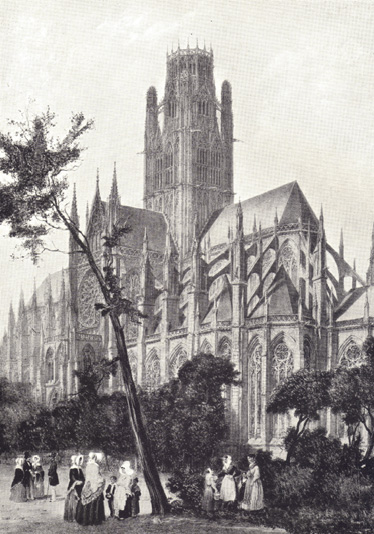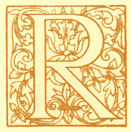
From, Beautiful Buildings in France & Belgium, Including many which have been destroyed during the war. Reproductions in Colour and Monochrome from rare old Prints and Drawings, by and after Prout, Boys, Coney, W. Callow, David Roberts, C. Wild and others, with descriptive notes, by C. Harrison Townsend, F.R.I.B.A.; New York: The Hubbell Publishing Co., 1916; pp. 176-179.
ROUEN : CHURCH OF ST. OUEN
(N. Chapuy)
 OUEN, still happy in the possession of many examples of mediæval architecture, was, till forty or fifty years ago, even richer in quaint old houses and buildings and picturesque winding lanes that appealed to the artist and architect. The replanning of the town and the formation of wide streets and boulevards have, however, swept away a large number of these, yet the town can still claim to possess three of the most important churches in Normandy — its Cathedral of Notre Dame, St. Maclou, and St. Ouen, the subject of Chapuy’s sketch.
OUEN, still happy in the possession of many examples of mediæval architecture, was, till forty or fifty years ago, even richer in quaint old houses and buildings and picturesque winding lanes that appealed to the artist and architect. The replanning of the town and the formation of wide streets and boulevards have, however, swept away a large number of these, yet the town can still claim to possess three of the most important churches in Normandy — its Cathedral of Notre Dame, St. Maclou, and St. Ouen, the subject of Chapuy’s sketch.
The Plate gives us a delightful rendering of the apse, transept, and tower of this, 178 the most perfect of the abbey-buildings of France, and, indeed, as Fergusson says, perhaps the most beautiful thing of its kind in Europe. He deplores, and naturally enough, the imperfect proportion and loss of aspiring character of the central tower, built, as it was, so much later than the body of the church.
Most of the building is of the date of 1318-19, but the Western façade and portal, the latter flanked by two towers, was not undertaken till 1846. The interior, exceeding the Cathedral in dimensions, and, indeed, in architectural interest, gains much of its lightness and beauty from the simplicity of its treatment and purity of style, and from the absence of non-essential ornamentation. The ancient stained glass, occupying the huge windows that almost displace the walls, and which —
Flecks the gloom with glow, dusking the sunshine,
is justly celebrated as presenting excellent examples of the work of the XVth and XVIth centuries.
Copyright © 2007 by Elfinspell